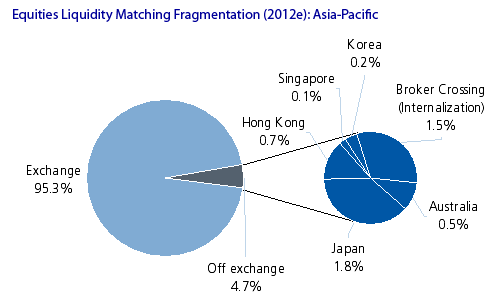The Evolution of Equities Market Structure in Asia-Pacific
Abstract
Market participants that expect the Asia-Pacific equities markets to resemble US and European market structure, even in the next few years, are likely to be disappointed. Ultimately, firms that can customize to the local markets and have sufficient capital and patience to wait out evolutionary trends will see potential upside in Asia-Pacific opportunities.
Asia-Pacific equities market structure and trading developments are still three to five years behind the maturity of the US trading landscape, as well as several years behind post-MiFID Europe. Unlike the US and European markets, where Regulation NMS and MiFID spurred innovation and fragmentation, however, there is no uniform catalyst to spur regulatory change in the Asian equities markets. Country-specific factors like regulatory restrictions on investor IDs, stamp tax and multiple currencies, and significant retail trading act as market structure barriers and limit the penetration of advanced trading, including high frequency trading (HFT), into individual markets.
For 2010-2012, Celent foresees a period of limited disruption for Asia-Pacific in terms of new venues and matching systems, resulting in relatively low fragmentation, according to a new report, The Evolution of Equities Market Structure in Asia-Pacific. Off-exchange crossing volumes should grow to 4.7% of total regional trading volumes in 2012, up from 1.1% in 2009. In tandem with a subdued view of industry fragmentation and disruption, Celent is optimistic for the health of Asian exchanges and predicts high trading volumes of 20–30% growth per annum.
"Increases in buy side trading sophistication will gradually support advanced trading strategies, including some HFT," says Neil Katkov, Senior Vice President, Asia, at Celent and coauthor of the report. “Greater utilization of advanced order types and trading tools like algorithms and smart order routing will expand in the region, but certainly not to the extent of US and European markets.”

“The transfer of advanced trading technology to brokerages and increased rates of buy side adoption of electronic trading and trading tools like algorithms, smart order routing (SOR), direct market access (DMA), and trading analytics mean that Asian markets will be transformed to favor firms who are ahead of the curve in adopting leading-edge technology,” adds David Easthope, Research Director for Celent’s Capital Markets Group and coauthor of the report.
"The markets most likely to see the greatest change in 2010 and 2011 are Japan and Australia, due to significant reforms of market structure,” adds Chermaine Lee, Celent Analyst and coauthor of the report. “Advanced trading strategies should expand in Australia in 2010-2011. ATS market share should also grow in both of these markets.”

